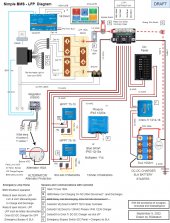@Goboatingnow
@svsagres has configured the system to control
HVD and charging, using
- REC BMS canbus with Wakespeed WS550 for separate advance shutdown of Alternator Charging.
- REC BMS to CerboGX to control and shutdown charging by the Solar MPPT and Phoenix 120vac charger
Which protects the LFP from HVD High Voltage Disconnect by the BMS. So for the "High Side" we essentially have a Toyota version of a "Top Notch" system.
Actually, we also have a system that also protects the alternator and electronic equipment from spikes.
@svsagres uses a Mosfet Smart BatteryProtect 65 to protect from LFP
LVD low battery protect and discharge.
My diagram, as the system stands now, does not meet the requirement that there is an advance action protecting the battery before the BMS LVD signal releases the relay coil to be "normally open". Of course if I am on the boat I can monitor for discharge and manually disconnect equipment, but if I am not on the boat? Then I must rely on the BMS and the one relay coil. Is this acceptable?
I assume the BMS will have an advance LVD alert, but have not shown it yet.





